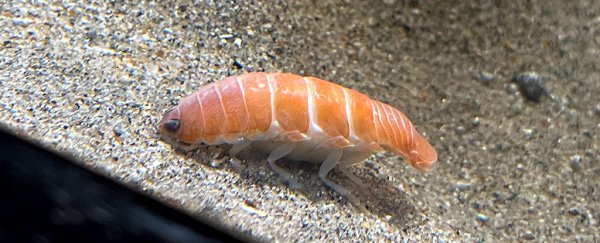Do not adjust your screen, and do not reach for the soy sauce. What you see before you is a real, living, breathing marine animal currently on display in a Japanese aquarium – a creature that just happens to look exactly like a piece of salmon sushi.
This snack of a sea creature is one of the most popular residents of Aquamarine Fukushima, a large aquarium on the east coast of Japan. In a Twitter post, aquarium staff identified the creature as an isopod – an order of long, flat, armor-plated crustaceans that are plentiful on land and in the sea.
The nigiri-shaped superstar likely belongs to the genus Rocinela, which includes more than 40 species, aquarium caretaker Mai Hibino told Vice.
未知の深海生物、白色のヒロメオキソコエビとウオノシラミ属の一種を展示を始めました。担当者はかわいくてしょうがないようで、「ほら、この角度いいでしょ!」とたくさん写真が送られてきますが、多くの職員の理解は得られず。。。#アクアマリンふくしま #深海生物 #親潮アイスボックス pic.twitter.com/sW12o3G2F4
— 【公式】アクアマリンふくしま (@aquamarinestaff) July 20, 2021
While many isopods eat dead or decaying animals, Rocinela isopods tend to be parasites that carve out cozy homes on the backs or among the internal organs of other sea creatures.
Most members of the genus appear dull and brown, but it's possible that Fukushima's famed sushi isopod may have taken more than just a meal from one of its former hosts, Hibino said.
Related: Marine marvels: Spectacular photos of sea creatures
"Because they're parasitic, we think maybe the color of the fish it was feeding on transferred [to the isopod]," Hibino told Vice.
Fishers caught the peculiar isopod in a net near the coastal town of Rausu on Hokkaido, Japan's northernmost island. The creature was captured at a depth of 2,600 to 4,000 feet (800 to 1,200 meters) and seemed to have a full belly upon discovery, Hibino said.
Sadly, there's no way of knowing exactly what the isopod fed on to achieve its raw-fish complexion. Measuring just 1 inch (3 centimeters) in length, the isopod could have easily stowed away on any number of larger sea creatures, the aquarium said.
This strangeness is par for the course for isopods; more than 10,000 species have been described to date, with diets, habitats, and sizes ranging wildly.
For instance, scientists writing in the journal ZooKeys in 2020 described the largest isopod ever detected: a puppy-size chonker whose sinister, domed shell earned it the nickname "Darth Vader of the seas". That's one crustacean we wouldn't want to invite to dinner.
Related content:
In photos: Spooky deep-sea creatures
In photos: The wonders of the deep sea
Photos: The freakiest-looking fish
This article was originally published by Live Science. Read the original article here.
